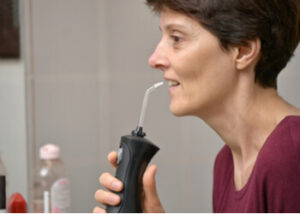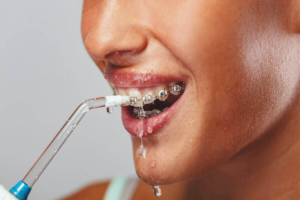Flossing is an important but often neglected part of everyone’s oral care routine. And, that’s not really surprising when you think about how tricky it is to use string floss. Using a water flosser can make the process of flossing much easier and quicker. Let’s take a step by step look at how to use a water flosser.
Why Flossing Your Teeth Matters?
Your job is to clean your teeth twice a day. Cleaning means brushing and flossing. While your toothbrush has a large surface area and lots of bristles, it does best at keeping the large surfaces of your teeth clean and plaque-free. What it can’t do is get in between your teeth, to clean those small spaces. And that’s important, because bacteria, plaque and debris can still get stuck there and need to be removed.
 Your mouth is full of bacteria that are contained in a sticky film that coats your teeth and tongue every day. This is called plaque, and it collects on your teeth, between your teeth and just below your gum line. Your toothbrush can’t dip just below your gum line, but flossing can.
Your mouth is full of bacteria that are contained in a sticky film that coats your teeth and tongue every day. This is called plaque, and it collects on your teeth, between your teeth and just below your gum line. Your toothbrush can’t dip just below your gum line, but flossing can.
When you floss, you also remove the plaque that may have accumulated at the base of each tooth. If left, this can contribute to tooth decay.
String Floss vs Water Floss
String floss is awkward to use. If your gums are tender or you get the angle wrong, you can make little cuts on your gums and cause them to bleed. If you have any condition that affects your ability to use your hands or fingers, this can also make flossing more difficult or even painful. Using the incorrect technique repeatedly with string floss can lead to tissue damage.
Water flossers offer a way to get around all of the disadvantages that people tend to associate string floss with and keep the focus on keeping your teeth clean. Water flossers can also compensate for a poor technique, allowing you to take advantage of technology to improve your dental hygiene. They can be used with different tips for specialised needs, such as when you wear braces or if you have periodontal pockets caused by gum disease.
Water Floss: How Does It Work?
Water flossers make use of jets of water that you must direct towards your mouth. Instead of using a piece of string to remove plaque, water flossers make use of the water jets to remove debris, plaque and bacteria from between the teeth. This makes the experience much gentler on your gums, easier on your hands and gives you a more reliable way to take charge of your dental hygiene.
How To Use Water Flosser: A Step By Step Guide
Be Prepared
If it’s your first time using a water flosser, you can expect to make a bit of a mess before you get used to it. Set yourself up in the shower or over the basin. It’s a good idea to do it in front of a mirror so you can ensure you give each tooth individual attention.
Open your mouth, tilting the head of the water flosser downwards. Trace the tip of the Waterpik along the outline of each tooth, making sure you follow the contour of your gum line at the base of each tooth. Try to hold the tip of the Waterpik at a 45-degree angle to your gum line.
Your Waterpik will have a switch to adjust the water pressure, which you will be able to do once you have started using it. If you’re unsure, start with the middle setting and then lower or increase it as you feel necessary.
You can expect to feel a slightly ticklish sensation when you start using water floss, but you will get used to the feeling the more you use it.
How To Use Water Flosser: Before Or After Brushing?
 It’s up to you to decide whether to floss before or after you brush. The studies that have been performed in this area do not yield much difference in terms of plaque removal. What is most important is that you floss twice a day and that you do it thoroughly.
It’s up to you to decide whether to floss before or after you brush. The studies that have been performed in this area do not yield much difference in terms of plaque removal. What is most important is that you floss twice a day and that you do it thoroughly.
Water flossers also rinse your mouth for you, as they squirt water jets into your mouth. They are also quicker to use than finding a new piece of floss for each tooth if you are using string floss.
The Benefits Of Water Flossers
Water flossers can offer a lot of help to patients who have:
Orthodontic Braces
A very high standard of dental care is required when you have dental braces. This is because the braces create small spaces that need to be cleaned to keep your mouth plaque-free. It’s very difficult to use string floss when your teeth are impeded by braces, and so water flossers can really make the difference in doing a great job.
How To Use Water Floss When You Have Braces?
You can use an orthodontic tip, designed especially for patients who have orthodontics. The tip is small enough to ensure that all the small spaces caused by your braces can be cleaned.
Gum Disease
When you have advanced gum disease, keeping your mouth clean can be a challenge. Patients who have periodontal pockets can benefit from using water flossers, as they do a good job at removing bacteria.
How To Use Water Floss If You Have Gum Disease?
You may benefit from using a special tip designed especially for treating gum disease. This can be used in conjunction with the Waterpik, with the water pressure on its lowest setting.
If you still have questions about how to use a water flosser, it’s best to speak to your dental professional for personalised advice. Please contact us for an appointment: (02) 8806 3799








